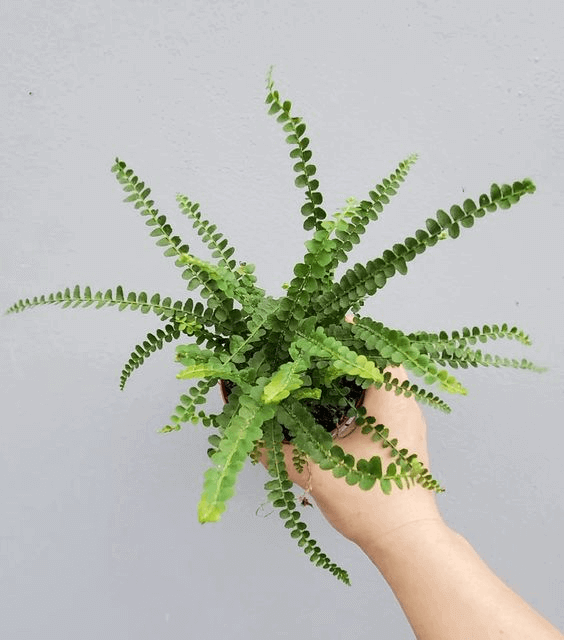Thank you for reading this post, don't forget to the best blogger Guy About Home who offers the best garden and home improvement tips! If you are a home decor and design fan, don't miss the tips on home ideas. If you are a home garden owner, then you might be interest in our complete guides to house plants!
Are you planning to grow a Lemon Button fern in your home and are wondering how to take care of it? Here’s a full fern Lemon Button care guide for you!
Lemon Button Ferns are smaller varieties of Boston ferns that are ideal for novice collectors. They are among the most attractive plants that you can get at an affordable price. They also give off a lemony scent, hence the name, during their active growing season.
Benefit From Caring for Lemon Button Fern

Source: Pinterest
Below are the key Lemon Button ferns benefits:
- Perfect for beginners
- Affordable houseplants
- Cutest and easiest ferns to grow
- Excellent air purifier
- High hardiness and low maintenance
Lemon Button Fern: Overviews & Facts

Source: Pinterest
Latin Name: Nephrolepis cordifolia “Duffii”
Common Names: Lemon Buttons / Lemon Button Fern, Fishbone Fern, Little-leaved Sword Fern, Erect Sword Fern, Button Sword Fern
Soil Type: Loamy, moist but well-draining
Lemon Button Fern Care: Things to Know
Is A lemon button fern easy to care for?
Lemon Button ferns thrive in moist and semi-shady locations in the woodlands. Similar to macodes petola, you will usually find them in forests and swamps but they can also withstand sea air as well as high-salt soils.
How big does a lemon button fern get?
These dwarf varieties of ferns can only grow up to 12 inches so they are perfect for terrariums. They got their name from their small size and round leaflets. Moreover, they have a moderate growth rate so they won’t require frequent repotting.
Features of Lemon Button Fern
As mentioned earlier, the plant’s leaves produce a lemony scent when crushed or handled. This is where the “Lemon” came from in addition to its golden-green leaves. On the other hand, the “Button” in its name is due to its round leaves with fine teeth. The leaves grow on both sides of the plant’s fronds making them look like thin fishbones.
Similar to other ferns, Lemon Buttons have shallow root systems called rhizomes that grow underneath the plant’s surface. Rhizomes allow the plant to absorb nutrients from the soil. They can also store energy more efficiently compared to thinner above-ground stems. Moreover, they are not easily affected by fluctuating temperatures since they are protected by the soil.
Are lemon button ferns toxic to cats & humans?
Lemon Button ferns are not toxic for cats and dogs as well as humans. This is another reason why these hardy and versatile ferns are chosen by many collectors.
How to Care for Lemon Button Ferns
We listed the Polyscias fabian indoor care tips below, to help you evaluate the plant is worth of growing. If not, you can try the other types of plants, ficus triangularis, trachyandra tortilis, crispy wave fern, monkey face orchid, manjula pothos,rose of jericho are also good options since they are easy to care for.
Besides this plant, we also make a full care guide on how to care for Macodes petola.

Source: Pinterest
Lemon button fern soil
For Lemon Button fern soil, you can use any well-draining houseplant soil but a loose, peaty soil mix would be best. You can also mix four parts peat and one part perlite. The plant can thrive in neutral potting soils but they grow faster in slightly acidic soils. Just add some coffee grounds or sphagnum peat to make the potting mix more acidic.
Lemon button fern pot
As for the pot, you can use a stationary or a hanging pot. And when choosing one, make sure that your plant will have enough space to grow. Drainage doesn’t really matter that much as long as you don’t overwater your plant because its roots might rot. You can put some rocks, stones, or pebbles on the pot’s bottom to avoid water from pooling around the plant’s roots.
Lemon button fern water
For Lemon Button fern watering, you don’t need to follow a strict watering schedule. Even if you water it often or once a week, your plant will still survive. But, make sure to mist it regularly to maintain the humidity level. One effective sign to know if it’s time to water your plant is if the topsoil is dry.
Lemon button fern light
For Button Fern light requirements, they can tolerate almost any type of lighting. May it be a bright light, indirect light, low light, or medium light. It is among the most versatile and adaptable plant varieties.
Lemon button fern temperature and humidity
These ferns love humid environments and warm temperatures so you should aim between 60°F to 70°F (15°C to 20°C). Avoid placing your plant near wood stoves, furnaces, and open fires because they can pull out the moisture from the air. You can use a humidifier or a pebble tray to increase the humidity in your plant’s environment.
Creating a pebble tray is more affordable. Just get a tray and fill it with gravel or pebbles before pouring water into it but do not cover the pebbles with water. The pot should not touch the water when you place it on top of the tray.
Lemon button fern fertilizer
Lemon Buttons are slow-growing. But if you want your plant to grow faster, you can fertilize it once a month in its growing season (early spring to summer). Use a half-strength water-soluble fertilizer that is designed for houseplants.
Lemon button fern pruning
Always prune dead leaves especially in the winter and autumn season to keep the plant neat. Make sure to cut at their base. In the spring season, sterilize your shears to avoid infecting emerging leaves while pruning. Simply wipe your shears using rubbing alcohol.
Lemon button fern repotting
It is time to repot your fern if it is already taking over its pot. For beginners, follow the repotting tips below:
- When you choose a new pot, pick one that is slightly bigger than the previous one. Do not get a pot with too much space because your plant can get overwhelmed.
- Loosen the plant’s outermost roots before repotting it.
- Put some potting mix in the new pot’s bottom before putting your fern on it. Fill in the remaining spaces with the potting mix.
- Water your plant generously. If the potting mix sinks after watering, just add more soil.
- Follow the other care tips we listed above.
How to Propagate a Lemon Button Fern
There are two main methods you can do to get new plants from your existing Lemon Button fern: division and spore propagation.
Besides this plant, we also make a full care guide on how to propagate Monstera standleyana.
Lemon button fern propagation by Division
Dividing your plant is the simplest and most feasible technique you can use to propagate your plant. The chances of your plant surviving are also higher compared to spore propagation. This method involves splitting your mother plant to create smaller sections with enough root balls and fronds to make sure that they will survive.
When you divide your plant, be very careful with the roots because extensive trauma can shock your fern and kill it. The roots should still be intact after division to ensure higher chances of survival. After dividing your plant, secure each individual section and plant them. Make sure to use well-draining soil and keep the soil moist to stimulate your plant’s growth. Follow the care tips we mentioned in the last section.
Propagating lemon button fern by spores
In their natural habitat, Lemon button ferns reproduce through spores. Like longevity spinach, spore propagation is easier in the wild because passing wildlife and the breeze can help in transporting the spores. This is not possible when you grow ferns as houseplants and it can be challenging to harvest spores. This process can also take months and is not recommended for beginners. But if you still want to give it a try, you can follow the steps below:
- Find Healthy Fronds With Mature Spores.To find mature spores, you will need a 10X handheld magnifying glass.
- Immature spores are almost white or pale pink while mature spores are darker and almost black. If your plant is old enough, you can easily find mature spores on its fronds.
- Remove healthy fronds with mature spores and put them inside a plastic bag until they dry out.
- Collect and Plant the Spores.Once the leaves are dry, you can just shake the plastic bag to get the spores from the fronds.
- Put the dry spores in the recommended potting medium we specified in the next section.
- Get a saucer, fill it with water, and place the pot on it to moisten the soil.
- Finally, put the pot inside a plastic bag and place it in a bright and warm location (at least 65°F). Again, it will take months before you will see little fronds growing from the spores.
Lemon Button Fern Pets& Diseases
The common pests that are attracted to Lemon Buttons are mealybugs, spider mites, whiteflies, aphids, and slugs. The common symptoms of pest infestation are wilting, stunted growth, spots on the leaves, thin webs in the plant, and silvery trails. Small pests are often found on the underside of the plant’s fronds.
Lemon Button Fern care tips
Besides this plant, we also summarize the caring issues and concerns on the plant Philodendron Painted Lady.
Lemon Button Fern pests
Since this plant is a hard one, it rarely gets affected by diseases or pests. But in case they do, you can easily resolve the problem. There are a few ways you can get rid of these small pests. You can just rinse and wipe off the plant to wash any pests away. If the pests still won’t go away, spray your plant with neem oil or insecticidal soap. Repeat this treatment every 3 days until you no longer see any sign of pest infestation.
For the slugs, you won’t really encounter them unless you put your Lemon Button fern outdoors. To get rid of them, apply some diatomaceous earth powder around the soil’s top. The powder’s gritty texture will lacerate the slug’s soft skin and lead them to death.
lemon button fern brown tips
Though the plant doesn’t require much maintenance unlike other plants, you still need to create the right environment for it to grow healthy. Its leaves are not known to drop or turn brown easily. Its water requirements are also not as demanding compared to similar varieties.
Like Crispy Wave ferns, Lemon Button ferns can survive indoors given that you give them the proper care they need. Same as hoya wayetti, they are perfect for making your home feel like a spa which you can’t do with other houseplants.
Lemon Button Fern Indoors VS Other Indoor Fern Varieties
#1 Staghorn Ferns
- They grow on tree barks in Africa, Asia, and Australia
- Thrives in coarse and well-draining soil
- They have two types of fronds:
- Green fertile fronds that look like stag horns, have spores and can reach up to 4 feet long
- Brown infertile fronds that are short, round, and flat
#2 Maidenhair Ferns
- Among the most fragile types of ferns
- They have small leaves and thin black stems
- Challenging to grow because they grow best in humid atmospheres but can’t withstand misting and direct sunlight
#3 Holly Ferns
- Its leaves look like those of holly bushes
- Dark green leaves that can measure up to 4 inches
- Water, heat, and light tolerant
- Available in 3 species: East Indian, Hawaiian, and Japanese holly ferns
#4 Boston Ferns
- Most popular types of houseplant ferns
- Dark green leaves that have many indentations in their edges
- Their fronds can grow very big
#5 Rabbit’s Foot Fern
- Wiry-looking ferns that are resilient indoors
- Long and furry rhizomes and triangular fronds that give the plant a bushy appearance
- The fuzzy rhizomes resemble a rabbit’s feet
Lemon Button Fern Outdoors VS Other Outdoor Fern Varieties
Here are outdoor ferns that you can use to decorate your flower garden or backyard for landscaping purposes:
#1 Cinnamon Ferns
- They frequently grow along streams and creeks so you need to water them very often
- They can grow up to 5 feet tall
- They have two types of fronds:
- Bright green infertile fronds
- Deep brown fertile fronds
#2 Bird Nest Ferns
- They grow on soil, rocks, and trees
- The middle part looks like the nest of a bird
- Wide leathery fronds that are similar to banana leaves
- Their fronds appear wrinkled under the sun
#3 Asparagus Ferns
- Fuzzy-looking ferns that proliferate well
- They can be tall growing or scrambling
- Their leaves can cause skin irritation even if they appear furry and soft
- They are invasive so you need to prune them frequently
- They produce red berries
#4 Australian Tree Ferns
- Ferns that look like palm trees and grow up to 50 feet tall
- Thick trunks that sprout large fronds of up to 8 feet long and 19 feet in diameter
- They grow in areas with warm temperatures and heavy precipitation
#5 Japanese Painted Ferns
- Ideal for regions experiencing harsh winters
- They can withstand temperatures of up to -30°F
- Their tapered fronds can come in a mixture of silver and purple colors
#6 Ostrich Ferns
- They are the most majestic and tallest type of outdoor ferns
- Fronds can grow up to 5 feet long
- Leaves that are growing upwards
Lemon Button Fern Care: In Summary
lemon button ferns are easy to care for and grow slowly so you don’t have to check them often like other plants. Just as hoya pubicalyx, but if you want to boost their growth, fertilizing them won’t hurt. Since they are small ferns, they are perfect to grow in vivariums. Plus, they are easy to propagate. These are the main reasons why Lemon Button ferns are popular among many hobbyists.
For more amazing ideas you can have, visit Guy About Home today or you can check the related blogs. If you want to other plant care tips, check the below:
- Monstera Siltepecana: A Complete Guide For Caring Monstera Siltepecana
- 7 Plants You Should Plant In A Perennial Hanging Baskets
- How To Take Care Of Succulents
- The Ultimate Guide to Growing Tomatoes
- How To Improve Garden Soil Quality for Maximum Plant Growth
- Anthurium Clarinervium Care
- Your Complete Guide on How to Grow Potatoes




